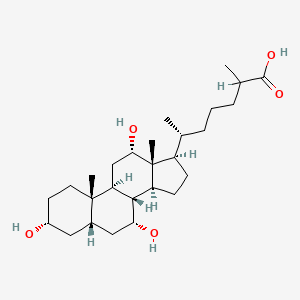| Authors | Title | Published | Journal | PubMed Link |
|---|---|---|---|---|
| pmid: | ||||
| ten Brink HJ et al. | Heterogeneity in di/trihydroxycholestanoic acidaemia. | 1994 | Ann. Clin. Biochem. | pmid:8060102 |
| Dahlbäck H et al. | Conversion of 5 beta-cholestane-3 alpha, 7 alpha, 12 alpha, 26-tetrol into 3 alpha, 7 alpha, 12 alpha-trihydroxy-5 beta-cholestanoic acid by rabbit liver mitochondria. | 1988 | Biochem. Biophys. Res. Commun. | pmid:3288204 |
| Dirkx R et al. | Beta-oxidation in hepatocyte cultures from mice with peroxisomal gene knockouts. | 2007 | Biochem. Biophys. Res. Commun. | pmid:17442273 |
| Ostlund Farrants AK et al. | Differential induction of peroxisomal oxidation of palmitic acid and 3 alpha,7 alpha,12 alpha-trihydroxy-5 beta-cholestanoic acid in rat liver. | 1990 | Biochim. Biophys. Acta | pmid:2223856 |
| Ostlund Farrants AK et al. | Identification of 3 alpha, 7 alpha, 12 alpha-trihydroxy-5 beta-cholest-24-enoic acid as an intermediate in the peroxisomal conversion of 3 alpha,7 alpha,12 alpha-trihydroxy-5 beta-cholestanoic acid to cholic acid. | 1989 | Biochim. Biophys. Acta | pmid:2930767 |
| Croes K et al. | Evidence for the importance of iron in the alpha-oxidation of 3-methyl-substituted fatty acids in the intact cell. | 1995 | Biochim. Biophys. Acta | pmid:7893739 |
| Wanders RJ et al. | Accumulation and impaired in vivo metabolism of di- and trihydroxycholestanoic acid in two patients. | 1991 | Clin. Chim. Acta | pmid:1839974 |
| Setchell KD et al. | Liver disease caused by failure to racemize trihydroxycholestanoic acid: gene mutation and effect of bile acid therapy. | 2003 | Gastroenterology | pmid:12512044 |
| Une M et al. | Stereospecific formation of (24E)-3 alpha,7 alpha,12 alpha-trihydroxy-5 beta-cholest-24-en-26-oic acid and (24R,25S)-3 alpha,7 alpha,12 alpha,24-tetrahydroxy-5 beta-cholestan-26-oic acid from either (25R)- or (25S)-3 alpha,7 alpha,12 alpha-trihydroxy-5 beta-cholestan-26-oic acid by rat liver homogenate. | 1984 | J. Biochem. | pmid:6520115 |
Coprocholic acid
Coprocholic acid is a lipid of Sterol Lipids (ST) class. Coprocholic acid is associated with abnormalities such as Exanthema, Peroxisomal Disorders and Cholestatic liver disease. The involved functions are known as Protonation, Cytokinesis, Oxidation, Anabolism and Process. Coprocholic acid often locates in Blood, peroxisome, Membrane, Endoplasmic Reticulum and Mitochondria. The associated genes with Coprocholic acid are THEMIS gene. The related lipids are Fatty Acids, methyl cholate, pristanic acid and branched chain fatty acid.
Cross Reference
Introduction
To understand associated biological information of Coprocholic acid, we collected biological information of abnormalities, associated pathways, cellular/molecular locations, biological functions, related genes/proteins, lipids and common seen animal/experimental models with organized paragraphs from literatures.
What diseases are associated with Coprocholic acid?
Coprocholic acid is suspected in Exanthema, Cholestatic liver disease, Peroxisomal Disorders and other diseases in descending order of the highest number of associated sentences.
Related references are mostly published in these journals:
| Disease | Cross reference | Weighted score | Related literature |
|---|
No disease MeSH terms mapped to the current reference collection.
PubChem Associated disorders and diseases
What pathways are associated with Coprocholic acid
There are no associated biomedical information in the current reference collection.
PubChem Biomolecular Interactions and Pathways
Link to PubChem Biomolecular Interactions and PathwaysWhat cellular locations are associated with Coprocholic acid?
Visualization in cellular structure
Associated locations are in red color. Not associated locations are in black.
Related references are published most in these journals:
| Location | Cross reference | Weighted score | Related literatures |
|---|
What functions are associated with Coprocholic acid?
Related references are published most in these journals:
| Function | Cross reference | Weighted score | Related literatures |
|---|
What lipids are associated with Coprocholic acid?
Related references are published most in these journals:
| Lipid concept | Cross reference | Weighted score | Related literatures |
|---|
What genes are associated with Coprocholic acid?
Related references are published most in these journals:
| Gene | Cross reference | Weighted score | Related literatures |
|---|
What common seen animal models are associated with Coprocholic acid?
There are no associated biomedical information in the current reference collection.
